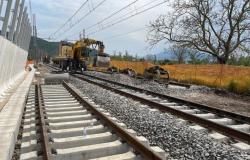ALEXANDRIA – The engineer Claudio Lombardiformer Environmental Councilor of Alessandria during the mayor’s administration Redthus commented on the decisions of the Province that they have stopped the production of C6o4 at the chemical center of Spinetta.
“On 26 February 2021, with protocol resolution 20210011988 n° DDAP2 – 155 – 2021, the Province of Alessandria authorized Solvay Specialty Polimers Italy SPA to produce and use the patented PFAS substance called cC6O4 subject to compliance with 32 requirements. The premise to the description of the requirements is particularly important: “The production of cC6O4 is authorized for a maximum of 60 t/year and its subsequent use must be implemented guaranteeing the absolute integrity of the plants and the related distribution network, both intermediate and of the finished product. Given the toxicity and persistence of the aforementioned substance, dispersion of the product within the production site must be avoided. The presence of the hydraulic barrier downstream of the plant, regardless of its capacity or otherwise to retain all the groundwater that flows below the plant, cannot be considered a safeguard against plant losses”.
The most important provisions (in my opinion) useful for the correct reading and criticism of the documents in question:
– every 6 months Solvay must issue reports on the inspection and maintenance of pipes and containment basins that may contain cC6O4 with ARPA analyzes and send them to public bodies.
– Solvay must install control piezometers in the areas of the cC6O4 production departments by sending reports every 3 months
– Solvay must build by 05/31/21 the design and construction timetable of purification systems that are much more efficient than the current ones: vibrated reverse osmosis and nanofiltration system
– By 2023 it must reduce ADV production by 99%.
– as of 1 February 2024, the wastewater discharged into the Bormida must have a cC6O4 content of less than 0.5 ?g/l and from 1 February 2023 an ADV content (omitted) of less than 0.5 ?g/l.
– The P4 exhaust emission limit values (it is the point at which the exhaust channel coming from Solvay flows into Bormida, ed.) will be considered respected if the daily average obtained from 24 hour samples is lower than the value indicated in prescription 7 ) that comes before.
– Solvay must provide at its own expense for the construction of an automatic water sampling system at the discharge point in Bormida electronically connected to ARPA which can activate the sampling procedure (point P4)
– Solvay must communicate to the Province, Municipality and other interested public bodies the waste management procedure and in particular the CER 070207 waste (procedure called “Coagulo”)
– The resins and activated carbons of the PFAS abatement system must be “traced” and the traceability accessible to public bodies
We wonder whether the aforementioned requirements were fulfilled by Solvay and within the expected timescales as they are very relevant for the considerations we report below.
– For a more understandable interpretation of the documentation in question, the following is specified:
– A production plant interacts with the environment in two ways: to function it necessarily produces effluents (liquid and solid waste). The solids are accumulated in internal landfills which must be authorized or in external landfills which must be traceable. Liquid waste must be collected and conveyed through an appropriate sewer network to purification plants from which a pipeline containing substances purified in compliance with integrated environmental authorizations (AIA) departs and is introduced into appropriately authorized waterways.
– Leaks (modestly called “diffuse”) from pipes or components of production plants are prohibited. These losses concern solid, gaseous and liquid compounds. The documentation issued by the Province concerns the liquid effluents that percolate into the aquifers and therefore we will deal with these below.
Regarding the warning to Solvay regarding the discharge of Solvay wastewater into the Bormida, engineer Lombardi remarked that “It all started with a citizen’s report on the presence of persistent foam and brown stains at point P4 of the discharge channel in Bormida on 17 May 2014. “Immediately Solvay, through an interview with the plant manager, declared that it dealt with normal foams caused by the turbulence that is generated in the waterfall that emits the plant wastewater into the river (point P4) taking care to demonstrate its scientific culture to call the waterfall “weir”, “pour epater les bourgeois” as the French would say. Dramatically denied by the publication of the analyzes on the samples taken by ARPA. The observation we make is the following: the authorization to produce cC604 was issued on February 26, 2021 with 32 prescriptions. No. 8 provides for very frequent sampling in order to obtain the prescribed annual limit for both cC6O4 and ADV. A citizen’s report to 112 was necessary to activate ARPA controls! It seems clearly demonstrated that the Province’s resolutions are not correctly complied with by ARPA or that the Province does not care to enforce them! Furthermore, confidential documents sent by ARPA to the Province and cited in the “warning” contain the precise values of the samples analyzed and results “non-compliant”. The non-compliance concerns only cC6O4 while the note published on the Arpa Piemonte website states verbatim “Several PFAS compounds including ADV and PFOA were found in a foam sample taken from the A101A pre-tank.” The pre-tank collects the effluents when they are not compliant: why not report the exact values?”.
“The “non-compliant” value of cC6O4 reported in the warning is 3.02+/- 1.81 ?g/l: we believe that more precise measurements than those carried out by ARPA are technically feasible with a tolerance of +/-60% given that it has legal value the minimum value. In any case, cC6O4 exceeds the prescribed values by 9.66 times to 2.42 times. It should be remembered that Solvay appealed to the TAR in 2021 against the limits imposed by the authorization to produce cC604, requesting limits 70 times higher. With a sentence dated April 2024, the TAR rejected it with the following reasoning: “It should be noted that the category of PFAS (i.e. perfluoroalkylated substances) groups together substances that are commonly used in the industrial field and which are found almost everywhere in the environment. These are very poorly biodegradable compounds and have long been the subject of attention by the scientific community, which monitors their effects on human health, due to their accumulation in the body (with increased risk of developing high levels of cholesterol and acid uric acid in the blood or other problems with the kidneys, liver, thyroid). According to scientific studies, due to their characteristics, Pfas persist for long periods in soil, air and water, they are transported by air and can contaminate water; humans are exposed to these substances through the ingestion of drinking water or foods coming from areas with high levels of Pfas, the inhalation of air containing dust, contact with contaminated surfaces or soils are able to pass the placental barrier and reach the fetus…Other studies highlight a correlation between exposure to Pfas and the increase, in the exposed population, in the incidence of hypothyroidism, hypercholesterolemia, mortality due to ischemic heart disease, cerebrovascular disease, hypertension, diabetes mellitus, Alzheimer’s/dementia, decreased fertility , etc”.
“With specific reference to the substance cC604, constituting a new generation short-chain Pfas, its effects have not yet been studied in depth as has happened for old generation Pfas. However, there are scientific studies that highlight the risks for the environment and for health: the available data concern acute toxicity and genotoxicity investigations conducted on rats, while other investigations (performed on clams) suggest the possibility that the aforementioned substance enters the trophic chain of other organisms up to man; furthermore, following analyzes on the possible pro-thrombotic effect of C604, it was ascertained that exposure to C604 at low concentrations induces platelet activation which “could induce a greater risk of cardiovascular events” (see the University report of Padua….). Furthermore, cC604 presents more worrying characteristics than historical PFAS in terms of greater mobility through water bodies, similar persistence, superior ability to escape purification treatments”.
“In conclusion, in our opinion it seems very light to take a simple warning as a measure against such a serious infringement. The ban on dumping until ARPA ascertains continuous and non-sporadic compliance with the limits appears much more correct as a measure.”
“The pollution caused by failure to comply with the provisions of this Determination appears to be equally serious if not greater. On 5 April 2024, Solvay reported that it had detected the presence of this substance in the subsoil adjacent to the cC6 O4 production department in quantities such as to induce it to suspend its production and to report itself to public bodies, in particular to the Province responsible for the authorization to produce (AIA) for this infringement. The analyzes carried out by ARPA have detected enormously high concentrations of this toxic substance in the soil with a peak of 1,021,034.1 ?g/l at a depth of 5/7 metres. By reaching the aquifer through leaching and runoff, the toxic substances cause pollution of extremely high proportions. For comparison purposes, compare it to the limit value of 0.5 ?g/l equal to that of the discharge point in Bormida.
The authorization provisions 2) and 3) respectively state:
2) every 6 months Solvay must issue reports on the inspection and maintenance of pipes and containment basins that may contain cC6O4 with ARPA analysis, sending them to public bodies.
3) Solvay must install control piezometers in the areas of the cC6O4 production departments by sending reports every 3 months
We ask ourselves: have the aforementioned reports to be sent by Solvay starting in 2021 every 3 and 6 months never highlighted the production of such pollution evidently caused by leaks from system components, pipes, sewers? In other and more explicit terms: did Solvay send the required reports and did ARPA check their correctness also with inspections and sampling? The continuation of the cC6O4 production “plant shutdown” by SOLVAY for almost two months suggests that the company is incapable of intervening effectively, most likely due to the serious obsolescence of the plants of which, especially with regards to sewerage, it may not be aware full localization. Solvay should therefore not be surprised by the Province’s injunction to suspend production which it has already suspended for two months.”
“Rather, it should be noted that Solvay, following the decision taken by the Province, has undertaken to “present a very extensive plan for the elimination of losses that the conference (evidently, although not mentioned, these are meetings between Solvay, the ARPA Province, the Municipality , ed.) has undertaken to check and verify” . But wasn’t this “conference” supposed to take place starting from 2021, from the moment of issuing the authorization to produce subject to compliance with the requirements? Finally, we conclude in total disagreement with the provisions reported in the document which will authorize Solvay to resume the production of cC6O4 at the same time as the release by ARPA of “specific technical evaluation regarding the effective resolution of the problems that led to the loss of cC6O4 in the past ″. In our opinion it must be explicitly imposed that non-episodic tests must be carried out and therefore over an adequate period of time that losses towards the aquifer have been completely eliminated”.





